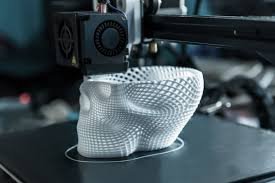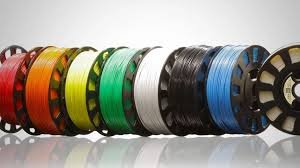3D Printing: Revolutionizing Manufacturing and Beyond
Introduction:
Three-dimensional printing or 3D printing, or even the broad term, additive manufacturing emerged from an obscure concept to a universally adopted technique in a very short span of time by influencing various sectors including aviation, pharmaceuticals, education and even consumer goods. This technology can build solid objects from materials placed in successive layers in line with a computer generated design. The use of 3D printing materials and techniques and operation of new software makes 3D printing as the profound innovative technology in design, manufacturing, and prototyping.
Brief History of 3D Printing:
Dr Hideo Kodama of Nagoya Municipal Industrial Research INstitute had protyped through rapid prototyping dating to early 1982. Therefore in 1984 Charles Hull invented 3D printer based on 3D printing process that is still up to date in terms of 3D printing – stereolithography (SLA) where the layers of photopolymer resin is cured by ultraviolet light.

Other 3D printing methods within the late 1980s and early 1990s were Fused Deposition Modeling, Selective Laser Sintering, etc.It proved more affordable as patents ended in mid-2000s and this led to the popular use of 3d printing in every market including industrial use.
3D Printing Works:
Design Creation: It is made with the help of a CAD program or obtained by scanning an object in 3D space.
File Conversion: The above 3D model is then sliced into thin layers or sliced into layers that the 3D printer can understand, and mostly these files are in STL format.
Slicing: An application software ‘cuts’ the model into layers which will be printed in thin layers subsequently.
Printing: The printer applies material layer by layer according to the cross-sectional model.
Post-Processing: The printing process can be of a material and technology nature so that the printed object may need to be cleaned, cured or some finishing process used to finish the printed object.
Types of 3D printing technologies:
Stereolithography (SLA): Ultra-violet laser welds a solid plastic matrix to liquid resin.
Fused Deposition Modeling (FDM): First, and far and away the most widely used technology in 3D printers utilized by consumers, extrudes a melted thermoplastic filament in layers.
Selective Laser Sintering (SLS): A solid forming structure is formed by fusing powdered material with a laser across its surface.
Digital Light Processing (DLP): However, this hardens the resin with a digital light projector, which is very much SLA but in digital.
Material Jetting: Photopolymer material droplets are deposited in a repeatedly layer by layer technique and exposed to UV light, which results in photopolymer material that is cured (exposed, ‘adds’).
Direct Metal Laser Sintering (DMLS): Metal powder is formed by bonding and sinterez to make metal articles.
Materials in 3D Printing:

3D printing in technology is still varied, using plastic or metal or even more biological material. The above material choice depends upon the application type, the properties for the end product and printer type as well.
Plastics: The well known types of plastics used today are PLA or Polylactic Acid, ABS or AcrylonitrileButadiene Styrene and PETG which is Polyethylene Terephthalate Glycol. These materials are preffered to develop prototypes and parts which need to be in work.
Metals: Applications vary from aerospace, automobile to healthcare and these parts are produced, using predominantly metal based 3PD materials such as stainless steel, titanium and aluminum to manufacture lightweight, strong and resilient parts.
Resins: SLA and DLP use photopolymer resins that are very clear, very accurate in layer resolution, that’s very flexible, very rigid as a material, and commonly used in dental mechanics and jewelry manufacturing.
Ceramics: Ceramic is used in developing heat and wear resistant parts in the art and industries parts, gadgets etc.
Biomaterials: New Technique in healthcare includes the use of biomaterials that are compatible in that they can be used to print organs, tissue related scaffolds and other implants.
Applications of 3D Printing:
1. Manufacturing and Prototyping
One of the most established applications of 3D printing is in production particularly in the development of prototypes. Earlier manufacturing processes needed intricate tooling and expensive molds for tooling; hence, manufacturing prototypes proved to be a costly affair. Another advantage of using 3D printing is that it leads to fast prototyping and thus, shortens the time and the expenses greatly.
Today, the technology is applied to direct manufacturing in addition to prototyping

depending with its capabilities for manufacturing complicated parts or small batches only. Companies, including automotive and aerospace, have been applying 3D printing to fine lightweight and high-performance parts in order to enhance the fuelling efficiency as well as to cut the expenses.
2. Healthcare
Bio printing is one of the categories the 3D printing which enables the fabrications of the tissue templates and organ mimics that helps researchers to analyze diseases and drug reactions more conveniently.
Other examples of using such technology include patient-specific surgical guides and implants, which are already a reality because of 3D printing. Doctors can create an actual model of a specific internal body part of a patient so that before operating on the real patient, one can rehearse on the model thus reducing the chances of a wrong move.
3. Aerospace
By designing and optimizing the local structures for 3D printing technology, the aerospace industry has been its pioneer in building light and strong parts. Turbine blades, the parts of the engine and the internal cabin accessories are made by non-traditional technologies like 3D printing because it has reduced the material wastage and has the advantage of creating geometries that would be challenging to be created by the conventional techniques.
4. Consumer Goods
The newest addition to the manufacturing technology is the affordable mere 3D printers making the value addition personal. People are now using 3D printers to manufacture small personal items which may also include special accessories such as mobile phone cases to household implements. The flexibility of making designs unique when the consumer wants is revolutionizing the market of consumer goods, introducing the notion of mass customization.
Benefits of 3D Printing:
3D printing offers numerous benefits techniques, including:
Cost Efficiency: 3D printing save cost of making prototype and small production through the removal of the necessity to acquire costly molds and tooling.
Customization: 3D systems provide great potential for the development of uniquely designed parts, different from what is necessary for a standard functioning of the goods.
Complexity Without Added Cost: Complex parts are expensive to manufacture in tradition manufacturing since costs are proportional to the complexity of the part; on the other hand, 3D printing of complex geometries does not have added costs.
Reduced Waste: Part by part creation models use only needed material adding layer after another in contrast to the subtractive methods such as CNC machining where a lot of material is removed to achieve a specific shape.
Rapid Prototyping: It makes it possible for designers and engineers to use the prototypes and come up with other modified models within the shortest time possible, thus shortening the process of developing the product.
Challenges and Limitations:
3D printing holds enormous potential, it is not without its challenges:
Material Limitations: It is not possible to fit any material into 3D printing, and several kind of printed material may not withstand mechanical characteristics that may be necessary in some uses.
Speed: Limitations of 3D printing are however that 3 D printing for large scale production can be slow compared to the conventional methods depending on the design required.
Post-Processing: Most of the time, certain parts of manufacture require other procedures such as washings, smoothing, or curing hence increasing the time taken and cost.
Quality Control: The changes in the printing conditions including temperature and humidity may impact on the quality or the standard of the printed objects.
The Future of 3D Printing:
It is predicted in the nearest future:
Some of key trends include more details in bioprinting in the medical field, trend of 3D printing in aerospace /automotive industries and large scale buildings through 3D printing.
Conclusion
3D printing has begun to disrupt many industries the flexible, efficient, and unique manufacturing process it provides. But as the technology progresses further and further, design, production, and even healthcare domains seem to change as well. Although the problem we have with it is not solved yet, the opportunities for using 3D printing as the tool for creating the different world in the fields of manufacturing, medicine, and people’s lives are vast.
With the use and adaptation of this technology firms and individuals stand to benefit as they are able to explore new ideas, ways of working and thepreferred degree of customization.








3 thoughts on “3D Printing: Revolutionizing Manufacturing and Beyond”